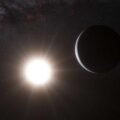In the ongoing search for life elsewhere in the universe, one group of scientists believes that Jupiter’s moon Europa could be a great place to look. Specifically, scientists are focusing on Europa’s what might await beneath Europa’s icy crust.
While it may seem odd to look at a place so cold and far away from the sun for signs of life, scientists also believe that Europa may be a good place to survey for habitability. Because of this, in late 2024 the Europa Clipper mission will be launched by NASA with funding from the Planetary Missions Program Office’s Solar System Exploration to probe Jupiter’s icy moon and weigh such prospects.
Background: Could an ocean world be habitable?
Ocean worlds are groups of planetary bodies that have vast liquid water oceans beneath thick ice crusts. Europa’s ocean is under 10 to 15 miles of ice, which is closer to the surface in comparison with other icy moons.
“Europa is fantastic. Of anywhere in the solar system, outside the Earth, it has the greatest potential, I think, for maintaining a habitable environment that could support microbial life,” Michael Bland, a US Geological Survey space scientist in Flagstaff, Arizona, recently told Wired.
If Europa possesses the ingredients needed for life, water will be of key significance. Fortunately, Europa is likely to have more water than our planet’s ocean. There’s also the need for essential chemical ingredients like Carbon, Oxygen, and Nitrogen. Scientists believe that not only Europa had these common elements at formation, but also it collected more organic materials from asteroid and comet impacts.
However, there is the remaining question about a possible energy source. How can an icy world so far away from the Sun get energy?
The answer is radiation. Jupiter blasts radiation to the surface of Europa, meaning that life on its surface wouldn’t be possible. However, the radiation Europa receives could actually create ideal conditions for life below the surface.
Analysis: Digging for life
Bland and his colleagues stated that trying to characterize the habitability of Europa is the logical next step. Fortunately, they won’t have to wait very long to find out, with the forthcoming launch of the Europa Clipper in 2024.


“The Europa Clipper will assess Europa’s habitability and how we might be able to use these investigations for other ocean worlds, thinking about the potential for life there as well,” says Kathleen Craft, a planetary scientist at Johns Hopkins University Applied Physics Laboratory.
Armed with solar panels, the orbiter will use radar, radio signals, and gravity to study Europa’s structure and measure the thickness of its shell and the depth of the ocean. It will try to absorb some droplets from the ocean that the planet frequently expels, some gas, and vapor. After analyzing and classifying the contents, it will send the most relevant data back to scientists here on Earth.
This orbiter’s mission also includes studying the surface of Europa to find a potential landing spot for a future mission, to gather surface materials, and maybe conduct some drilling on the icy shell.
Outlook: The final countdown
The opportunity to explore Europa is approaching fast, and soon we’ll know more about not just its habitability, but also that of other oceans worlds. Combining all the right ingredients needed for life isn’t easy, but Bland believes there’s a chance for life on Europa’s seafloor.
“It’s plausible, but specific conditions have to be met, and it’s not guaranteed,” Bland says.
The only way to know for certain is by exploring this icy world through new space missions. “The Europa Clipper mission will take a profound step in advancing our understanding of habitable environments beyond Earth”, wrote NASA’s Samuel Howell and Robert Pappalardo, Europa Clipper team members, in the journal Nature Communications, last year.
The data the orbiter is hoped to acquire will provide useful information about the structure and depth of Europa’s surface and ocean and it might even collect some samples of water that erupts through the ice. But most importantly, it will help prepare the best way to take the next step in this exploration: landing a spacecraft in Europa.
This landing mission remains a concept, for now, but using a lander might be the only way to know if there’s, in fact, life in another world.
While the prospects for landing on Europa at some point in the future remain in the conceptual stage for now, future missions in the months and years ahead could make them a reality. If successful, they could also help answer the long-standing question of whether there is life on other worlds, and even on cold, desolate moons like Europa that might have initially seemed inhospitable to Earthlings.
Raquel is a forensic geneticist turned freelance writer. She has a knack for technology and a passion for science. You can follow her at scitechcorner.com and on Twitter @theRaquelSantos.
